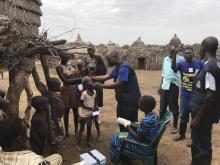Oral Cholera Vaccination campaign to combat cholera in South Sudan concludes despite security and access challenges
16 August 2017, Juba, South Sudan – The first round of an Oral Cholera Vaccination (OCV) campaign in four priority counties of South Sudan with active transmission of cholera, has successfully concluded despite security and access challenges in some areas. The vaccination campaign started on the 29 July, 2017 to 4 August, 2017 in the Kapoeta state including Kapoeta South, Kapoeta North, and Kapoeta East while in Tonj East the campaign started on 5 August, 2017 and ended on 12 August, 2017.
A total of 500, 010 doses of the vaccine, targeting of 500,000 people were deployed across the four counties. A second round of OCV will be administered across the four counties after 14 days to ensure effective protection against cholera for the affected populations.
Over 19 000 cases of cholera and 355 deaths have been reported in South Sudan since June 2016. To combat the disease, the Ministry of Health with support from WHO and partners has adopted OCV as part of the integrated approach to tackle cholera prevention and control in the country. Cumulatively over 611 564 people have so far received the first dose of OCV and 161 321 the second round prior to the current OCV campaign. The OCV efforts have played a vital role in controlling the spread of the disease resulting, in significant decline of cholera cases in the 11 sites where the oral cholera vaccines have been deployed in 2017.
“People were eager to receive the vaccine and many turned up at the launch at the freedom square here in Kapoeta town,” said Laurence the Kapoeta South County Health Department. “Every day, there was an increasing demand and long queues at different vaccination sites and we were hopeful that all the 97 000 people would receive the vaccination.”
The vaccines were donated by the Global Task force on Cholera Control(GTFCC) as part of the global response strategy. The Ministry of Health and WHO in collaboration with UNICEF supported the shipment of campaign logistics including OCV and cold chain equipment to the four counties. WHO provided technical support to the implementing health partners, and coordination of the campaign. The campaign was implemented by the American Refugee Committee, Save the Children, International Organization on Migration (IOM), Comitato Collaborazione Medica (CCM) and The Health Support Organization (THESO).
A total of 350 069 out of a target of 500 000 people across the four counties were reached by the campaign, representing a coverage of 67% of the target population. Kapoeta South and Tonj East recorded highest coverage above 80%, that is, 80.9% and 85.1% respectively. Kapoeta East recorded 68.4% and coverage for Kapoeta North was very low at 31.4% due to insecurity.
In Kapoeta North, insecurity hampered OCV campaign efforts in the state by Save the Children, which deployed a total of eight vaccination teams to the area.
“The OCV campaign started off well with a launch attended by the State leadership and we planned to vaccinate 141 520 people, through 8 fixed sites supported by 56 mobile outreach teams” said Koki Giberto, Operations Lead for Save the Children. “However due to insecurity, the campaign was interrupted after vaccinating 3 752 people on the first day. Our staff, and other NGOs - Adventist Development and Relief Agency (ADRA) and the Carter Center staff were evacuated from Irwoto in Kapoeta North to Kapoeta South”.
Despite the setback, the campaign later resumed and a total of 44 438 people (31.4% of the target) were vaccinated, with a mop up round planned to improve coverage.
There was a similar situation in Kapeota East where the OCV campaign targeting 97 000 people also commenced with the launching of the campaign after training and deployment of the vaccination teams. Social mobilization, and advocacy were also well conducted. However due to insecurity the implementation was also interrupted and a total of 66 300 (68.4%) people were vaccinated.
To address the low coverage, partners have planned to remobilize and re-strategize for a vigorous mop-up in those areas before the second round is rolled out.
Dominic Franco, the WHO Field Coordinator for former Eastern Equatorial State noted that the deployment of OCV will be very helpful in interrupting the cholera transmission especially in communities where water, sanitation and hygiene measures have been difficult to institute especially among pastoralists.
An additional two million doses of oral cholera vaccines are required to mitigate the risk of cholera in high risk areas and to interrupt transmission in the areas with ongoing transmission. WHO is in the final stages of securing these additional doses to complement the ongoing cholera response, and plans to undertake the next round with partners in the coming weeks.



